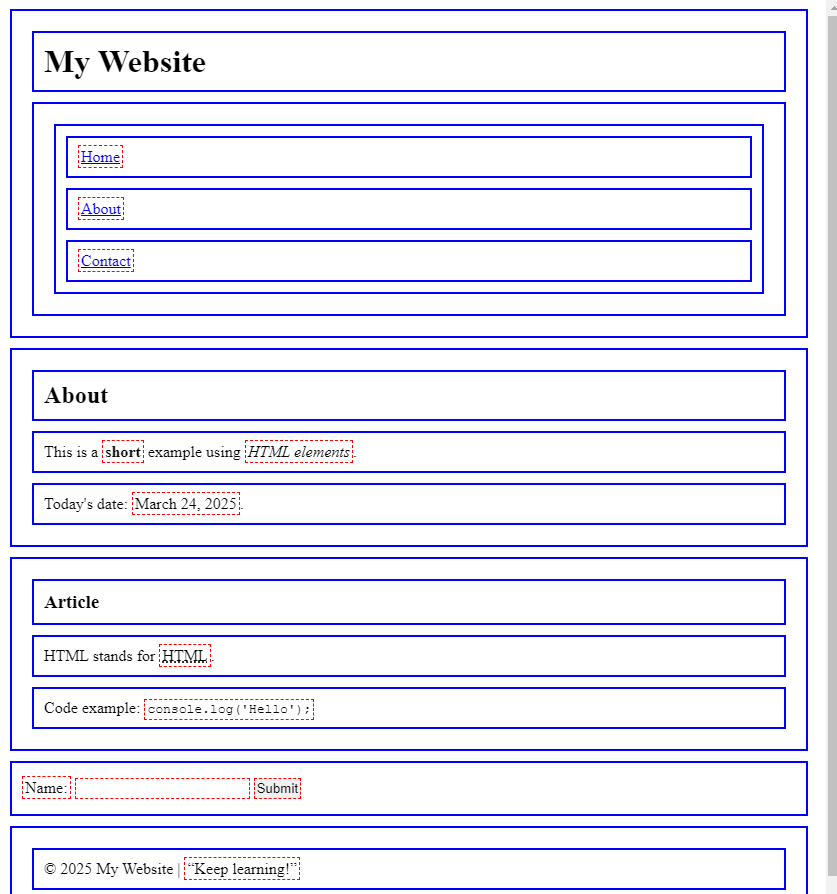Block vs. Inline Elements in HTML
 Abdul Matin
Abdul Matin
Understanding the difference between block and inline elements is crucial for writing clean, structured HTML. Let’s break it down with a practical example! 🔥
🔹 Block Elements: These take up the full width available and start on a new line. Examples: <div>, <p>, <section>, <h1> - <h6>.
🔹 Inline Elements: These only take up as much width as necessary and do not force a new line. Examples: <a>, <strong>, <em>, <span>, <label>.
💡 Here's a visual representation:
<!DOCTYPE html>
<html lang="en">
<head>
<meta charset="UTF-8">
<meta name="viewport" content="width=device-width, initial-scale=1.0">
<title>Block vs Inline Elements</title>
</head>
<body>
<!-- Block Elements -->
<header>
<h1>My Website</h1> <!-- Block -->
<nav>
<ul> <!-- Block -->
<li><a href="#">Home</a></li> <!-- Block (li), Inline (a) -->
<li><a href="#">About</a></li>
<li><a href="#">Contact</a></li>
</ul>
</nav>
</header>
<section> <!-- Block -->
<h2>About</h2> <!-- Block -->
<p>This is a <strong>short</strong> example using <em>HTML elements</em>.</p>
<!-- Block (p), Inline (strong, em) -->
<p>Today's date: <time datetime="2025-03-24">March 24, 2025</time>. </p>
<!-- Block (p), Inline (time) -->
</section>
<article> <!-- Block -->
<h3>Article</h3> <!-- Block -->
<p>HTML stands for <abbr title="HyperText Markup Language">HTML</abbr>.</p>
<!-- Block (p), Inline (abbr) -->
<p>Code example: <code>console.log('Hello');</code></p>
<!-- Block (p), Inline (code) -->
</article>
<!-- Block Elements (Form) -->
<form>
<label for="name">Name:</label> <!-- Inline -->
<input type="text" id="name"> <!-- Inline -->
<button type="submit">Submit</button> <!-- Inline -->
</form>
<!-- Block Elements -->
<footer>
<p>© 2025 My Website | <q>Keep learning!</q></p>
<!-- Block (p), Inline (q) -->
</footer>
</body>
</html>
🎯 CSS Styling for Visibility
/* Block Elements */
header, nav, ul, li, h1, h2, h3, p, section, footer {
border: 2px solid blue;
margin: 10px;
padding: 10px;
display: block;
}
/* Inline Elements */
a, strong, em, label, input, button {
border: 1px dashed red;
padding: 2px;
display: inline;
}
Code Output:

✨ Why Does This Matter?
✔️ Helps in better layout structuring
✔️ Essential for CSS styling & positioning
✔️ Crucial for responsive design
Check out my github to access full source code:
What’s your biggest challenge with HTML elements? Let’s discuss in the comments! 👇🔥
Subscribe to my newsletter
Read articles from Abdul Matin directly inside your inbox. Subscribe to the newsletter, and don't miss out.
Written by

Abdul Matin
Abdul Matin
I am Abdul Matin. I specialize in JavaScript, React, Node.js, MongoDB, and Full-Stack Web Development. Every day, I document my learning journey, breaking down industry-level concepts into real-world applications. Key Technologies I Work With: JavaScript (ES6+) | TypeScript React.js | Next.js Node.js | Express.js MongoDB | PostgreSQL REST APIs | GraphQL Web Performance Optimization | Security Best Practices.